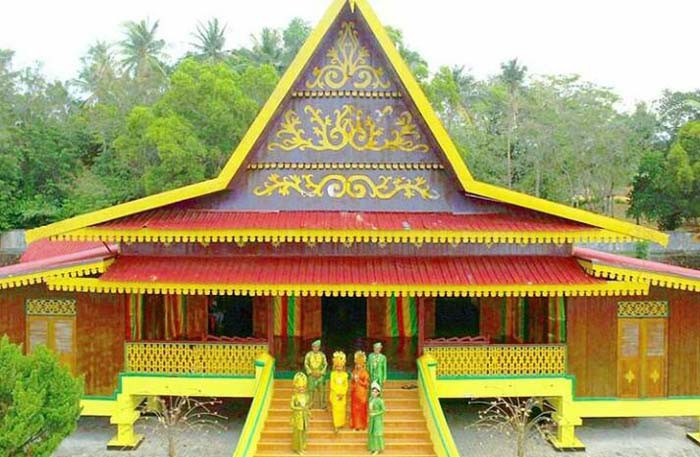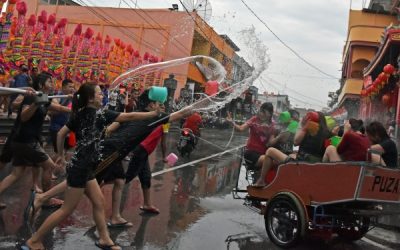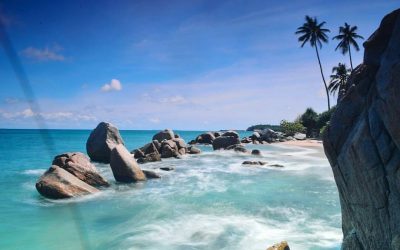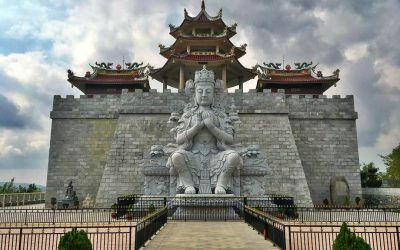Home / Batik Regions – Western Indonesia – Northern Sumatra – Riau Islands / Daik Lingga Royal Palace
Cultural Destination
Embrace the spirit of the place!
Daik Lingga Royal Palace
Penyengat Island is a small island in the City of Tanjungpinang, Riau Islands, which is approximately 2 km away from the city center. The island offers a variety of cultural destinations, especially the wonder of Riau – Lingga royal palace complex. The royal complex consists of the Grand Palace, Sultan Penyengat Grand Mosque, and various tombs of the kings of Riau-Lingga. Many castles, ports and freshwater wells are also well preserved on this island. Known as the birthplace of the Indonesian Malay language, this cultural site is popular as a literature tourism site. Raja Haji Ahmad from the Sultanate of Riau-Lingga (1808–1873) was the first person who composed the Indonesian Malay Language Guidebook. His works include the famous poem Gurindam Dua Belas, which set the ground basis for the development of Indonesian literature.
Tourist Attractions in Riau Islands
Cian Cui Festival
Cian Cui Festival is originally an annual tradition of the Chinese descendants in
Bintan Trikora Beach
If you want to see a stunning view of granite beach, this place offers a great
Ksitigarbha Buddhist Temple
The Bodhisattva Ksitigarbha is known as the Buddhist temple with a thousand faces
Riau Islands
Batik Motifs
Gonggong Beruntun
This motif illustrates that a person should maintain a positive attitude and
Ikan tambal
The word “Ikan” refers to fish. The philosophical meaning of Ikan Tambal means is
Tikar Natuna
The Tikar Natuna motif is adapted from the traditional making of pandanus mats in
Gonggong Siput
Gonggong (Strombus Turturella) is one type of sea snail found around
Discover
Indonesian
Batik
Motifs
Gigi Haruan Lidi
The Gigi Haruan Lidi motif is taken from the name of the cork fish and is a symbol of
Mahkota Siger
Siger is the crown of a noblewoman in ancient time. It is a symbol of femininity, strength, and
Dayak Taghol
Dayak Taghol has a distinctive style of four curved lines and small dots. This motif represents
Kawung
The Kawung motif was created by Sultan Agung Hanyokrokusumo (1593 – 1645) as a symbolic gift for
Jupri Kembang Teh
Kembang Teh illustrates the tendrils of tea plants that grow in the highlands of
Desa Na Tolu
The Desa Na Tolu characteristic pattern symbolizes the Batak philosophy of existence and
Bale Lumbu
This motif signifies the welfare of the ancient Sasak society. Bale also symbolizes the
Ukir Sentani
The Ukir motif is a batik motif that is inspired by various traditional Sentani wood carvings
Bultiya
The word ‘Bultiya’ is an acronym of the three major tribes in North Kalimantan, namely
Biji Kopi
The coffee seeds motif illustrates the pride of local coffee specialities in
Rumah Mamuju
the Batik motif illustrates the house of Mamuju King with the stairs, located on the left of the wooden stage house
Ikan tambal
The word “Ikan” refers to fish. The philosophical meaning of Ikan Tambal means is
Bomba Mawar
This motif means sacred love for family, kingdom, and God; It also illustrates
Gajah Way Kambas
The motif illustrates the Lampung’s natural reserve, the Way Kambas. it also symbolizes
Kuda Kupang
Horses symbolize wealth. It contains noble values of virtuous characters that bring
Wakatobi
It symbolizes the coastal beauty of the Wakatobi island and the symbol of Patra symbolizes
Tampuk Manggis Sasirangan
The motif illustrates the philosophy of the mangosteen fruit, which is
Sero Tangga
The Sero Tangga illustrates an endearing feeling and sacrifices of a person to fulfil
Tangerang Herang
Tangerang Herang motif is a symbol of Tangerang city. The Tangerang Herang batik motif consists of
Cengkeh
The clove flower motif is the main commodity of the Tolitoli Regency. This motif represents
Karawo Pinang
Pinang refers to the Palm areca tree. This motif is considered as the original
Kaharingan
The Kaharingan or ‘tree of life’ based on the Dayak tribes’ belief system. This tree symbolizes
Burung Bidadari
Bidadari birds are endemic birds in Halmahera. This motif represents an
Manguni Minahasa
Manguni is identified as the symbol of the Minahasa people. Manguni is known as a
Angsa Duo
According to legend, the Angso duo batik motif is a pair of swans that are believed to have led Princess
Insang Ikan
Insang refers to the gills of the fish. This is a typical pattern of Malay ethnic who inhabits
Tabir Tanjung
Tanjung flower is a type of Cherry tree flower, which is commonly found in
Sekar Jati
Sekar means flower and Jati refers to teak trees that symbolizes a strong mental character that
Kain Cual
Cual textile tradition has existed since the 17th century. The word “Cual” refers to
Rangkiang
The word “Rangkiang” refers to the rice granary in the Minangkabau language. It symbolizes
Kasih Tak Sampai
‘Kasih Tak Sampai’ is an idiom in the Indonesian language which refers to
Durian Pecah
Broken Durian motifs depict the foundation of faith. The second half signifies the mastery of
Pala Salawaku
This motif illustrates the unique weapons of the Maluku region, namely
Parang Seling
Parang Seling or “alternating daggers” is a royal batik motif. It is a feminine variant of
Hiu Taliyasan
Indonesia is also home to the world’s largest fish, the whale shark (Rhincodon typus). Hiu Taliyasan refers to
Gentala Arasy
Built as high as 80 meters, the tower also highlights the historical side of
Tongkonan
Toraja’s traditional house is called Tongkonan. Tongkonan is a place for
La Galigo
La Galigo is a literary work of the Buginese Epic that has 300 thousand epic lines. It is considered even
Pucuk Rebung Riau
Pucuk Rebung symbolizes heart determination in achieving goals, good luck, and
Raja Ampat
Raja Ampat motif represents the marine life at Raja Ampat archipelago in
Malinau Cultural Festival
You will witness a unique competition that might not be found other than in
Kerawang Tegak Aceh
The Vertical Upright (Kerawang Tegak) Motif symbolizes a person who has a strong
Daun Simpor
This motif is inspired by the Simpor plant (Dillenia Suffruticosa) which is a typical
Sido Mulyo
Sidomulyo is one of the classical motifs, which is specifically used for the bride’s costume in
Sekomandi
Its philosophical meaning is the eternal union which refers to a saying “until death do us part”
Lipaq Sabe
Lipaq Saqbe contains a simple geometric classical motif with various flower decorations. This textile is
Awan Berarak
Awan Berarak is a combination of Dayak motifs and Malay patterns. The word ‘Awan Berarak’ means the
Ake Patra
Ake is related to the divinity and the composition of the universe. It is a symbol of
Jumputan Bintang
The word Jumputan means the tie-dye technique, while the word “Bintang” refers to
Gurdo Solo
Gurdo or garuda bird is the mount of the Indian god Vishnu. As the Sun Bird,
Daun Lada Hitam
The black pepper motif represents the main commodity of Bangka Belitung
Parang Rusak
Another meaning behind this motif is an unconquerable spirit, symbolized by
Tifa Totobuang
The batik motifs illustrate Maluku’s traditional music instrument called
Honai
The Honai is inspired by the traditional house of the Papuan community living in
Keluak Daun Pakis
The word “Keluak” is a Minang language which means twisted or tangled. The Motif of
Tenun Bima
The motifs are adopted from Bima woven textile. This pattern has received a great
Tikar Natuna
The Tikar Natuna motif is adapted from the traditional making of pandanus mats in
Srimanganti
The name of the Srimanganti motif is derived from Palace’s hallway that connects to
Kaganga Tanah Rejang
If Batik Besurek combines Arabic calligraphy motifs, then the Kaganga batik takes
Dayak Kamang
Kamang motif is generally found in the Dayak tribe shield because it is believed to
Gumin Tambun
Based on Hindu mythology, this motif symbolizes lucks, abundant wealth, and
Gonggong Beruntun
This motif illustrates that a person should maintain a positive attitude and
Tengkawang Ampiek
With its many advantages, the Dayaks use this leaf in ritual ceremonies. This plant is a symbol of
Buketan Bali
The Balinese bouquet (Buketan Bali) is a floral arrangement and the name is
Pinawetengan
The Pinawetengan Batik pattern was taken from a prehistoric inscription in
Enggang Dayak
Local people beliefs that hornbills are an incarnation of the Commander of the Birds. It has supernatural
Salakanagara
Salakanagara batik motif illustrates the first kingdom in the Betawi land
Gedhog Kembang Waluh
a combination of Javanese cultural motif of the Majapahit kingdom (XII-XIV century) with
Wirasat
Wirasat or divine inspiration is a gift from God. This inspiration is symbolized by
Gonggong Siput
Gonggong (Strombus Turturella) is one type of sea snail found around
Tanah Liek
The word “Tanah Liek” refers to clay in Minang language. It is also known as
Bintik Tujuh
The Bintik Tujuh (Seven Dots) motif has 7 white spots and green color gradation as
Merak Ngeram
The hatching peacock motif has a very deep meaning which refers to the sacrifice and
Teguh Bersatu
This batik motif shows the strength of the people of Kupang. It also represents a sense of
Besurek Rafflesia
The term “Basurek” refers to a textile that contains letters or inscriptions




